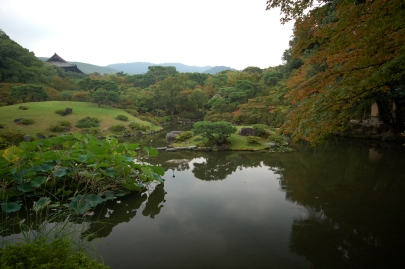
Yesterday we back tracked along the Shinkansen line to Osaka, then headed onwards to Kyoto. We’re staying in a ryokan here, which is meant to be a traditional Japanese style of accommodation. However judging from the private bathrooms, air conditioning and LAN port, I don’t think this place can be considered too traditional.
We’re in Kyoto for the next three days, so we’re doing a few day trips to local areas. Today we visited Nara – former capital of Japan, home of eight World Heritage sites and the stomping ground to herds of well fed deer. Nara Park is where most of the action is, as it contains shrines, temples, pagodas, gardens, primeval forests and the unavoidable deer.
Holly had been reading up on Nara in Lonely Planet, and was convinced we should make the trip there, but it was only when I was standing under a 50m tall pagoda that I started to realise why this place was a must see. And it just kept getting better. Next stop was Issui-en, a garden dating from the late 1800s. Thankfully it seems the other tourists hadn’t been able to navigate the numerous back streets required to find it, or were too busy feeding deer (you can’t walk 50m without seeing someone selling Deer Crackers – “It’s awful for people!”), so we were left in peace to soak up the atmosphere, the only disturbance the occasional sound of the gardeners tending to the plants. That brief moment of peace and quiet ended as soon as we headed back through Nara Park to Todai-Ji.
This temple is all about size. You walk through a massive wooden gate, in which two giant carved figures stand guard. The main hall is the largest wooden building in the world, and it contains one of the biggest bronze figures in the world, a 437 tonne Buddha. If you’ve seen the episode of Monkey where he think he’s flown to the end of the universe, but then discovers he only reached the end of Buddha’s arm, well it’s not quite that big, but it’s getting close.
A trek further into the park took us to a shrine called Kasuga Taisha which is surrounded by hundreds of stone lanterns, buried in a thick forest. Even in the mid-afternoon it had a very eerie quality, and I imagine it would look amazing at night all lit up.
As we headed back to the station it started raining, so we took shelter and had a late lunch in MOS Burger, seemingly the only competition in the burger game McDonald’s has here. We were quite impressed with the burgers on offer, and also with the chicken hats the staff were wearing.
Unfortunately the rain only got worse after we left MOS Burger, and we were absolutely soaked by the time we made the train back to Kyoto. The rain was still going as we trudged back to the ryokan, and upon arriving I realised that perhaps a non-traditional ryokan with a hot shower wasn’t such a bad thing after all.
Yes, thanks to Andrew Lancaster for recommending MOS Burger. My chicken teriyaki burger visibly contained chicken, while the sauce on Sim’s hamburger tasted as though it had been made from actual tomatoes. Tiny, though.
that photo looks really nice, I want to go! I hope you’re having lots of fun – even in the rain- it sounds like you are, anyway, hope to hear from you again soon.
Hi Simeon,
My parents visited Japan in the 80’s and loved it. Its been on my radar for some time.What I’m interested in, is the cost of normal things. How much would it be for a Big Mac (in Oz Dollars), how much for a regular sushi meal and what about average accommodation?
Its interesting you mentioned that history is not far away regarding traditional buildings etc. I wonder how much was destroyed during WW2. Continue to have a great time and I’ll follow your blog with great interest.
Sayonara
Klaus
Hi Klaus,
From our experiences so far, the perception that Japan is really expensive doesn’t ring true. Food wise, I think what you get for the price is a lot better than you would get for the same money in Australia. You can get some really great food (and be full) for as little as ¥600 (of course you can spend ten times that if you want to go a bit more upmarket). Perhaps if we were buying groceries we’d notice more of a difference.
I’m going to write a post about our different types of accommodation later on, but other than being a bit smaller than we’re used to, we’ve found it pretty comparable to hotels back home, and often breakfast here will be included.
In terms of things being destroyed during the war, a lot of the castles and temples have been built and rebuilt many times due to internal conflicts, and those that survived that and the wars have undergone a lot of restoration work anyway. It’s hard to tell what’s original and not anymore (at least for us untrained tourists).